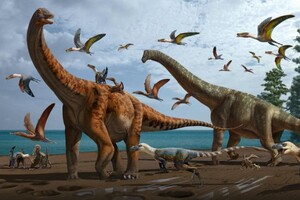Dinosaur bones indicate that animals used to be larger.

In ancient times the Earth was inhabited by giant animals. Among them were powerful dinosaurs, pterosaurs the size of an airplane, giant crocodiles and snakes, as well as armadillos the size of a car. But today there are few large species left on our planet. Why did this happen? The answer to this question is published by Live science.
There is a lot of fossil evidence that giant animals lived on Earth in the past. Not only were they gigantic, but their average size was larger than that of modern fauna, said Greg Erickson, a paleobiologist at the University of Florida. Ever since scientists unearthed the first batch of dinosaur bones in the 19th century, they have been trying to explain why giant animals were common millions of years ago, but are rare today. But, according to Erickson, no one can give an unequivocal answer.
Read also: Scientists have discovered 224 new species of animals and plants in Asia
However, this fact can be explained by several key differences between dinosaurs and today's large mammals. Like other reptiles, as dinosaurs grew, they could adapt to different niches, hunting for smaller prey at a young age and larger prey in adulthood. This was partly due to the fact that they changed different sets of teeth, as sharks do. That is, as reptiles grew larger, they changed their youthful set of teeth to larger “weapons” that allowed them to hunt for larger prey.
According to paleontologist at the University of Edinburgh Steve Brusatte, dinosaurs' air sacs spread from lungs to bones, creating strong but light skeletons. Due to this, the skeletons of dinosaurs were strong and flexible, but still light, which allowed them to grow bigger and bigger. Mammals do not have air sacs that can penetrate the bone and make it lighter.
Like warm-blooded or endothermic animals, mammals need a lot of food, and dinosaurs were cold-blooded animals. This means that the elephant needs about five times more food than the largest dinosaurs.
Paleontologists are debating whether the dinosaurs were warm-blooded or cold-blooded. Modern science places animals in a gradient between cold-bloodedness and warm-bloodedness, and dinosaurs were probably in the “lower part of the cold-blooded range.” That is, the large body of the dinosaur was less energy consuming.
The gigantic size of the body required an appropriate environment. In a study published in 2016, scientists concluded that gigantism is directly dependent on a sufficient number of resources produced and processed by “highly developed environmental infrastructure.” That is, there must be enough oxygen, food, and space in the environment for a giant creature to grow up. Such environments developed in the middle of the Triassic period, closer to the beginning of the dinosaur era.
In the ancient atmosphere there was a higher concentration of oxygen. This may have played an important role in the development of gigantism, especially in insects. A 2012 study found that the wingspan of fossil insects showed an increase in oxygen concentration.
In addition, time played an important role. It takes a long time for an species to evolve to gigantic proportions. Mass extinctions usually destroy large creatures, so the niches of such animals may remain unfilled for tens or even hundreds of millions of years.
“It took the first mammal 25 million years to reach a ton of weight,” said Herat Vermei, a professor of geobiology and paleobiology at the University of California, Davis. For example, woolly mammoths became extinct only 10,000 years ago. Therefore, it is not surprising that modern humans do not see such giant creatures: our ancestors helped to destroy them not so long ago.
Vermey believes that the most comprehensive explanation for the reduction in animal size is not based on physiology and environment , and from the social structure. According to him, “the evolution of organized social behavior, not only herds, but also truly organized hunting” in mammals has led to a new form of dominance. Group hunting of even relatively small predators makes even a very large prey vulnerable. “Individual gigantism on land has actually been replaced by group gigantism,” he said.
lost its luster on land, “says Vermei.
The social organization may explain that there are still the largest known animals in the ocean: blue whales. The marine environment makes it difficult to communicate over long distances, which makes it difficult to create large hunting groups.




